Car maintenance tips, from the car-bibles.com website. Basic car maintenance tips for the motoring enthusiast.
Car Maintenance Tips
Throughout the rest of this website you'll find in-depth articles describing in intricate detail how everything automotive works. On this page, I've simplified all that knowledge into a series of basic car maintenance tips, subdivided by category. These tips apply to pretty much every car owner, from business fleet owners, to specialists like a limo service, to the weekend hobbyist. Basic car maintenance really isn't that hard. There are simple things that you can do on your own like being able to use a silicone lubricant to protect your car from rusting. Some tips have simple explanations right here whilst others link back to the articles in the rest of the site. If you can't find what you're looking for, try the search button at the end of the top menu. If you still can't find what you're looking for, or have a suggestion for something else I should cover, contact me using the contact button on the top menu bar.
TSBs and wiring diagrams
If you're looking for TSB (Technical Service Bulletins) or wiring diagrams for your vehicle, BBB industries have access to most of them for free. (Almost any decent car shop will have access to this sort of information - as the owner, you should too). BBB's search page is well worth a look. Major recalls normally result in owners being contacted, but minor ones get done each time a vehicle is taken to a main network dealer. TSBs are the bulletins sent to the dealer networks containing info on known bugs and issues with all makes and models that need to be rectified when the vehicles come in. If you're looking for a particular TSB or wiring diagram for your vehicle; TSBs and wiring diagrams.
Wheels and tyres
Rotate your tyres!
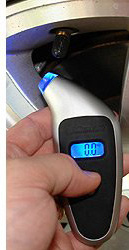
Every 5,000 miles or 8,000km, rotate your tyres.  Tyre rotation.
Tyre rotation.
Clean brake dust off regularly
Brake dust contains all sorts of nasty stuff. If you leave it too long, the combination of road grime, moisture and heat from your brakes will bake it on to your wheels. Brake dust normally clings to wheels with static electricity so a damp sponge and clean cold water is the best way to get it off.
Check your tyre pressures
Check your tyre pressures regularly - once a week is ideal. Bad tyre pressures can affect fuel economy, handling and comfort. It's easy to do and there is no excuse not to.  Checking your tyre pressure.
Checking your tyre pressure.
Check your tread depth
Bald, slick tyres might be good for motor racing but they're no good on the road. Most tyres come with tread wear bars built into them now - find one, examine it and if your tread is too low, replace your tyres. Four new tyres might seem expensive but they're cheaper than a fine or an accident.  Tread wear bars.
Tread wear bars.
While lurking on the Internet and collect the best tips for you, I tried to find the best online-resource with different wheels and tires. I found CARiD website as a really good place to do shopping: http://www.carid.com/custom-wheels.html They offer ultimate wheels and tires collection, largest selection and truly dedicated team of experts to help you!
Engine
Check your belts
At the front of your engine there will be a series of rubber drive belts that loop around various pulleys, driving everything from the alternator to the a/c compressor. Rubber perishes, more so in extreme conditions like those found in an operating engine bay. Get your timing belt and accessory drive belt checked every 25,000 miles, preferably replacing it every 50,000 miles. See the Fuel and Engine bible for information on interference engines and why checking your timing belts is a necessity, not a luxury:  Interference engines
Interference engines
Fuel Economy
Check your tyre pressures regularly - once a week is ideal. Bad tyre pressures can affect fuel economy very noticeably. It's easy to do and there is no excuse not to.  Checking your tyre pressures
Checking your tyre pressures
Checking your oil level
This is something everyone can do - it's quick and easy and it'll tell you if your engine needs oil. If the oil is too high or too low, it can cause trouble for your engine. To check the oil, park on level ground and wait until the engine has cooled down after driving, then locate the dipstick. Pull it out and wipe it clean, then push it all the way back in until the top of it is seated properly in the dip tube again. Wait a moment then pull it out again. Check the level of the oil. If it's between the high and low marks, you're fine. (If it's too low, add a little.) The high and low marks can be denoted by two dots, an "H" and "L" or a shaded area on the dipstick. The photos below show a Honda dipstick which has the two dots. Why not just read the level first time around? The first time you pull the dipstick out, it will have oil all over it and it will be difficult to tell where the level is. That's why you need to wipe it on a rag to get a clean dipstick, then dip it back into the oil to get a good reading. More information on why you should check your oil level is here  Checking your oil level.
Checking your oil level.

Checking your coolant level
Again, something everyone can do. The coolant is the other thing your engine cannot go without. Every engine is different but if you check your handbook you should find where the coolant reservoir is. It will normally be bolted to one side of the engine bay or the other, and be a white semi-transparent bottle. Wait until your engine is cool and take a look at it - the outside should have 'low' and 'high' markings on it and the level of coolant inside should be between the two.
Do not take the radiator cap off to check coolant levels. If the coolant system is still hot then it is still under pressure and the pressure release will burn you.  Engine cooling systems.
Engine cooling systems.
Like the site? The page you're reading is free, but if you like what you see and feel you've learned something, a small donation to help pay down my car loan would be appreciated. Thank you.
Fuel / gas
Will higher octane or premium fuel give me better gas mileage and/or more power?
No. Sportier cars have higher compression engines which generate more power and require higher octane fuel to prevent detonation. That's where the myth of "premium = more power" came from. If your handbook says "regular", use regular. See octane and power for more information.
Bodywork / paint
Keeping your paint finish in good condition
Only choose superior car detailing supplies to keep your car's interior and exterior like new. There are plenty of decent quality waxes and polishes on the market today and if the last time you waxed or polished your car was over a decade ago, things have changed considerably since then. The wax and polish compounds are far more sophisticated both in terms of protection from fading, the look of the finish, and the ease of application. For example Turtle Wax Ice gets rid of that old problem of white wax residue. Is a clean car a vanity thing? Partly, yes, but if you park under a tree where birds help repaint your car with recycled blueberries, that guck will come off a lot easier if it falls on a waxed paint job.
Tip: If you find a bird has pooped on your car, wash it off as quick as you can. There are compounds in bird waste that can damage most car paint jobs. If you leave it in the sun and the poop bakes on, you could end up with a dull spot in the paint.
Electrical
Disconnecting and reconnecting your battery
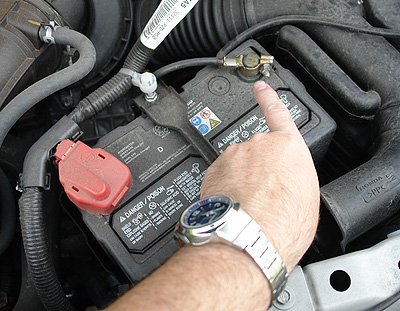
If you're going to do any work on your car involving the electrical system, disconnect the battery first. To do this, loosen the connector for the negative/ground terminal first, and wiggle the terminal cap off. Use a wire-tie or similar to tie the cable back out of the way. If you need to take the battery out, you can now take off the positive connector.
Why negative then positive? If you disconnect the positive side of the battery first, the negative side is still connected to the entire car. If you drop a tool and it lands on the positive battery terminal and touches anything else on the car, you'll have an electrical short. By disconnecting the negative first, you're cutting off the return path for the current. Now, if a tool drops on to either of the battery terminals, it doesn't matter if it touches part of the chassis or not - there's no continuous path for the electrical current.
Reconnecting your battery. Connect the positive terminal first, and the negative second - the reverse of removal, and for the same reasons. When you slip the negative connector on, there will be a spark as it gets close and makes contact with the negative battery terminal. Don't be afraid of this - it's nothing to worry about. Make sure the terminal caps are done up nice and tight.
Check your battery terminals
Most modern cars run on a 12 volt negative ground electrical system. If your battery terminals or contacts aren't clean, you're making it more difficult for the current to pass around the electrical system. Remove the terminal caps as described above and clean each contact post with a wire brush to get a nice clean metal contact surface. Do the same to the terminal caps, then reattach them as described above.
Lights
One indicator or blinker is flashing faster than the other
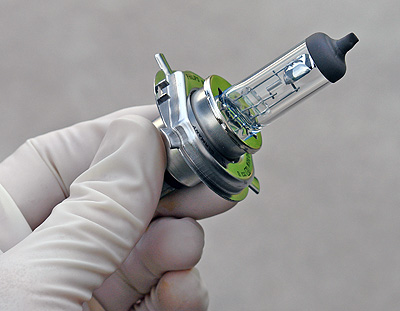
When you indicate one way and the blinker flashes quicker than when you indicate the other way, it means one of the bulbs has blown. An auto parts store will be able to tell you what sort of bulb you need to replace it with and your manual should show you how to get at the indicator bulbs - they're different on every car.
Don't touch the glass when changing headlight bulbs
Most headlight bulbs now are filled with halogen and have special coatings on the outside of the glass. If you pick the bulb up by the glass with your fingers, you will leave trace amounts of oil and grease on the glass. When the bulb is used, that area of the glass will get hotter than the rest and it will eventually cause the bulb to crack. When changing headlight bulbs, only hold the metal bulb holder at the base, or make sure you're wearing rubber surgical / mechanic's gloves (clean ones) if you're touching the glass.
Dash / instrument warning lights
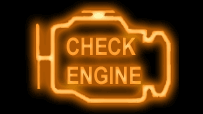 |
The check engine light.Every new car now comes with OBD-II - On Board Diagnostics 2. This is a fault-registering system connected to sensors all over the car, engine, fuel and emissions system. When the check engine light comes on, it can mean many things. There are something like 4,000 unique OBD2 codes that can be stored. Handheld OBD2 diagnostic tools can be plugged in to the OBD2 port which is normally under the dash on the driver's side. These tools can read out the fault code and/or reset the system to contain no codes. Codes are split into two categories - historical/inactive, and active. The historical codes are lists of things that have been detected in the past but are no longer an issue, whilst the active codes are things that are a problem right now. Codes are subdivided into B-codes (body), C-codes (chassis) and the biggest list of all - P-codes (powertrain). |
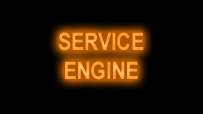 |
The service engine light / Maint Reqd light.This might indicate "Service", "Service Engine" or "Maint Reqd". It's an indicator that you're getting close to a scheduled maintenance interval. On some cars it's as simple as counting miles before it comes on, whilst on others it maps engine temperatures, oil temperatures, air temperatures and other indicators of probable stress to tell you when it might be time for new oil or a service. In most cars this can be overridden or reset by you, the owner. Your handbook will tell you if this is the case. If you take your car for a service, the garage should reset it for you. |
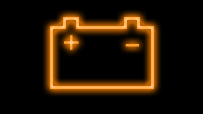 |
The electrical fault light.This warning light is different in every car but normally it looks like a picture of a battery, similar to the picture on the left here. You'll see it come on and go off when you start your engine as part of the car's self-test, but if this light comes on and stays on, it means the electrical charging system is no longer working properly. Think of it like a cellphone battery. If the cellphone is plugged into the charger, you can use it indefinitely, but when you disconnect it from the charger, there's a limited amount of time before your battery runs out. It's exactly the same in your car, only bigger. Every car has an alternator - the charger - and a 12v battery used to supply power to the electrical system. If the alternator becomes faulty or the drive belt to it snaps, then it will not be able to do its job. The longer you drive, the more your car will use up the remaining juice in the battery and eventually the engine will die. This almost always requires a new or refurbished alternator. |
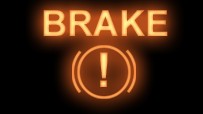 |
Brake warning light 1Most cars nowadays have a brake warning light on the dash. Its purpose is to alert you that something is wrong in the braking system somewhere. If it comes on, check your owner's manual to find out its meaning. The brake warning light doesn't have a standard meaning; it could be used for multiple purposes. For example, the same light may be used to show that the hand brake (parking brake for the Americans amongst you) is on. If that's the case and you're driving, you ought to have noticed the smell of burning brake dust by now. The light can also indicate that the fluid in the master cylinder is low. Each manufacturer has a different use and standard for this light. Which is nice. Because it would be such a drag if the same indicator meant the same thing in every vehicle. |
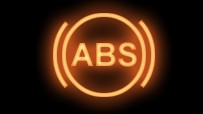 |
Brake warning light 2If you've got an ABS-equipped car, you also have a second light - the ABS light. If it comes on, get it seen to as soon as possible. It means the ABS computer has diagnosed that something is amiss in the system. It could be something as simple as dirt in one of the sensors, or something as costly as an entire ABS unit replacement. Either way, if that light is on, then you, my friend, have got 1970's brakes. It's important to note that this light normally comes on when you start the car and then switches off a few seconds later. If it blinks, throbs, flashes or in any other way draws your attention to itself, then take note. It's not doing that just to please itself. Compared to a steady light, a blinking ABS light normally indicates something more serious. In some cases it could be as bad as "you have no brakes at all." |
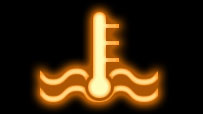 |
Coolant warning lightThis is normally the coolant level warning light. If this comes on it means that the level of coolant in your radiator is low and needs topping up. DO NOT OPEN THE RADIATOR CAP WHEN THE ENGINE IS HOT! The coolant system is pressurised and it could easily release pressure and spray you with boiling coolant. Do it when the engine is cold. Top up the system with either a pre-mixed coolant bought from a shop, or with distilled water. Don't use tap water - the mineral deposits in it boil out in the cooling system and calcium gets depositted around the inside of the radiator making it less efficient (which will eventually cause it to fail). It's always best to use pre-mixed coolant, or to mix your own rather than using neat water. The coolant mixture behaves as an antifreeze in winter as well as a corrosion-inhibitor to stop your engine rusting from the inside out. |
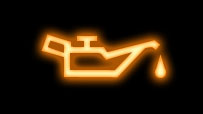 |
Oil warning lightTypically this light will come on if your oil pressure is too low. Low oil pressure is serious and if you continue to drive with this light on, eventually your engine will die. Low oil pressure can be caused by a failed oil pump, a blocked oil filter or strainer in the sump, or by low oil levels - for example if your engine is burning oil. Either way, you need to get it fixed, and fast. Low oil pressure is A Bad Thing and your engine won't thank you for leaving this problem untreated. |
Warning lights - further reading
I stumbled on a site in the UK that has even more explanations of the various warning lights you can find on your dash - head over and take a look if you're curious: Engine warning lights
Winter checks.
Another useful site with some more maintenance tips talks about 7 checks you should perform before the onset of winter - you can find that here: 7 vehicle checks you should perform before winter.
